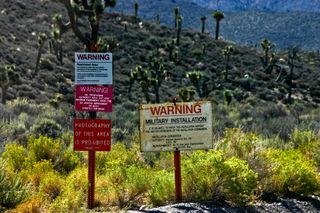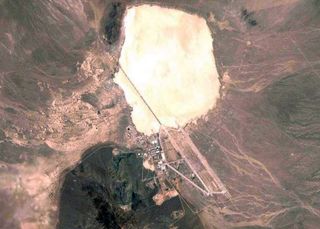Area 51: Secrets, Yes; Aliens, No
Area 51 is a military base about 80 miles northwest of Las Vegas, Nevada. With a few exceptions, though, it's mostly conspiracy theorists — and those who have been influenced by them through the countless TV, magazine, and website references — who call it "Area 51." To the U.S. government, it's simply the Nevada Test and Training Range, part of Edwards (formerly Nellis) Air Force Base. Employees will sometimes refer to it as simply "the site" or "the ranch."

Knowing where Area 51 is won't help you get there; the base is restricted to the public. On the ground, you'll encounter stern signs and armed guards patrolling the fenced perimeters; in the airspace above, you'll encounter threatening warnings from air traffic control towers. Either way, you'll find few answers as to what goes on inside the base near the Groom Lake salt flats.

Many believe that Area 51 is where scientists reverse-engineered alien technology that was recovered from crashes saucers in Roswell, New Mexico; oddly, there seems to be no evidence that the Pentagon has made use of any such advanced technology. "60 Minutes" correspondent Leslie Stahl suggested that the area was not UFO-related but instead a dumping ground for toxic waste.
Though the existence of the base was classified for decades, it has been officially acknowledged for nearly 20 years. It is a secret military base, and there are, of course, perfectly legitimate government and military reasons for keeping the base's activities secret that have nothing to do with aliens or UFOs. After all, the military needs places where they can test and develop new helicopters, airplanes, unmanned drones, and other technology away from public eyes. There is, of course, no way to selectively tell the public what's going on there, even if the government wanted to: spies and hostile foreign governments read the news and watch TV, too.
Debunked claims
The UFO claims surrounding Area 51 emerged most prominently in the late 1980s, when a man named Robert Lazar told a television station that he worked at Nellis as a physicist helping other scientists studying crashed flying saucers on top-secret projects. Predictably, it caused quite a stir among the UFO believers for many months; however, Lazar's claims were later disproven (by UFO skeptics and believers alike). He was found to have fabricated not only his employment at Nellis but indeed his entire background; almost nothing of what he said was true. Still, Lazar's lies propelled Area 51 into the public's consciousness, and a few others (perhaps seeking attention or book deals) later followed in his footsteps making similar "insider" claims about an extraterrestrial presence there.
Information vacuum
Like the party you're not invited to, what goes on there is interesting beyond your wildest imagination: crashed spacecraft, or extraterrestrial bodies, or super-secret military aircraft, or cutting-edge laser weapons, or weather-controlling devices. Or time machines, or whatever you can think of. Where a secret creates an information vacuum, wild speculation often fills the void.

Area 51 is now firmly entrenched in the public discourse about government conspiracy and UFOs. As Thomas Bullard, author of "The Myth and Mystery of UFOs" notes, "After trust between government and public eroded with Vietnam and Watergate, Roswell and Area 51 entered the popular vocabulary as bywords for official double-dealing. Suspicions no longer fester only within the UFO community [but] have spread through the public at large to leave scarcely any visible line between perceptions of literal fact and 'X-Files' plots."
The basic, flawed premise behind the Area 51 mythology can be boiled down to this: The government won't reveal what's going on there, so it must be something ultra-super-amazingly secret. But, of course, Area 51 is only one of many military bases, national laboratories, and government scientific research centers across the country that deal with classified — even top secret — information, and where workers and visitors need security clearances.
As with any good mystery, many people still endorse stories about Area 51 based on anonymous sources, speculation, rumor and conspiracy. The irony is that even if the government gave public tours of Area 51 detailing all its current and past secrets, UFO buffs wouldn't believe a word of it; they'd dismiss it as a disinformation campaign designed to hide the real truth. There's no reason to think that anything alien is going on there, but where there is secrecy, there will be conspiracy.
Benjamin Radford is deputy editor of "Skeptical Inquirer" science magazine and author of six books, including "Scientific Paranormal Investigation: How to Solve Unexplained Mysteries." His Web site is BenjaminRadford.com.
Related:
Sign up for the Live Science daily newsletter now
Get the world’s most fascinating discoveries delivered straight to your inbox.

